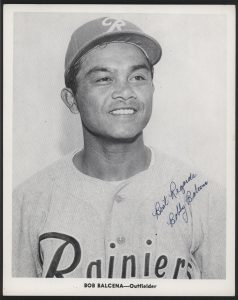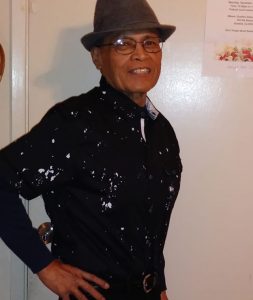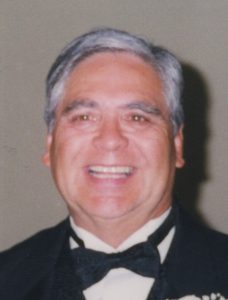PETER’S PINOY PATTER — JULY 2020
Bridge Generation News
(Today’s Bridge Generation – now in their 70s, 80s, and 90s – are a rapidly declining population. Over the years, most members of these American born children of the first wave of Filipino immigrants have passed away. To remember their contributions to the history of Filipinos in America, a deceased BG individual will be a recurring feature of this blog).
BRIDGE GENERATION PERSONALITY OF THE MONTH
Most folks remember this month’s featured personality as the first Filipino and first Asian to play Major League Baseball. On San Pedro’s (CA) Sportswalk, alongside famous names as Wilt Chamberlain and Don Drysdale, is inscribed the name Bobby Balcena (1925-1990).
 Born to Filipino immigrants Fred and Lazara Balcena, Balcena began playing baseball at the age of six. Considered to be one of the greatest high school athletes in San Pedro history, he starred in football, track, and baseball. He broke into professional baseball in 1948 with a bang. Playing with the Mexicali Eagles of the Sunset League, he led the league in batting with a .369 average. An outfielder, Bobby spent many years in the minors before being called up to the major leagues by the Cincinnati Reds in 1956. His major league career was much too brief as he appeared in only seven games, batting twice while fielding perfectly.
Born to Filipino immigrants Fred and Lazara Balcena, Balcena began playing baseball at the age of six. Considered to be one of the greatest high school athletes in San Pedro history, he starred in football, track, and baseball. He broke into professional baseball in 1948 with a bang. Playing with the Mexicali Eagles of the Sunset League, he led the league in batting with a .369 average. An outfielder, Bobby spent many years in the minors before being called up to the major leagues by the Cincinnati Reds in 1956. His major league career was much too brief as he appeared in only seven games, batting twice while fielding perfectly.
As he was being interviewed by the Los Angeles Times in January 10, 1990, Balcena grinned and declared, “I wasn’t up there long. But I was there.”
According to former Times artist and long-time friend Pete Entovoja,“Bobby was one of San Pedro’s all-time sports greats. As little as he was, he was one hell of a football player at San Pedro High School, as well as a super baseball player. If he had only been a little bigger, he would have been one of the immortals.”
Regardless, the 5-foot-6 ballplayer was a minor league star for 15 years before retiring in 1963, a sports hero for Filipino communities across America as well as in the Philippines. Bobby was particularly beloved by the Seattle Rainiers for his hustle, defensive skills, and hitting. He was Seattle’s most popular player and affectionately dubbed the “Filipino Flyer.” His most productive season for the Rainiers was in 1956 when he batted .295 and led the Pacific Coast League in doubles. Balcena died of natural causes in San Pedro in 1990.
Passings
 Joseph David Jamero Sr., of Livingston, CA
Joseph David Jamero Sr., of Livingston, CA
My kid brother died peacefully on May 7 after an extended illness with his immediate family surrounding him. Born on March 7, 1946 Joe was the eighth and last child of Ceferino and Apolonia Jamero — immigrants from Garcia Hernandez, Bohol. With sixteen years between us, I only got to know him well as an adult when we shared common experiences of the U.S. Navy, marriage, fatherhood, sports, and life. What I remember most of his early years is that he and his inseparable brother Silverio were always playing and rough housing. Even then Joe possessed that mischievous maldito look that was hard to resist.
In high school he earned varsity letters as starting guard in football and first-string catcher on the baseball team. His navy years were significant. Assigned to the Philippines, he met the love of his life, Lolita Rosquites, who he married on December 16, 1966. Ensuing years saw the birth of four children — Joseph Jr. (JoJo), Gabe, Jeff, and Angelita. Joe may have been the most popular person in Livingston as a result of his many years of working for the local U.S. Post Office. Always friendly, he was on a first name basis with customers; the sizable Filipino population always went to his window; other ethnic minorities were comfortable with him; co-workers loved him. He was so popular that people suggested he run for Mayor — he never did.
Active in the community, Joe and Lita chaired the annual Santa Nino celebration for years. Joe’s greatest legacy are his children and grandchildren. His greatest contribution – enabling Lita’s large family to immigrate to America – and from whom he earned their lasting gratitude, respect, and love. It was not surprising that despite COVID-19’s restrictions, his funeral services were well attended. The hundred-strong Jamero family and his many relatives and friends miss him greatly.
 Demitrio “Buster” Villa, May 20, 1920 in Stockton CA
Demitrio “Buster” Villa, May 20, 1920 in Stockton CA
Known for his perpetual smile and enthusiasm, Villa was born on August 30, 1935 in Youngstown, Ohio, to Apolonio and Lilly (Ballard) Villa, and moved with his family to Stockton at age six. Like most Bridge Generation youth he toiled in the agriculture fields with Manong Generation men. He attended San José State University before being drafted into the Army in 1958, serving two years of active duty. He worked for the Defense Depot (Tracy) and Sharpe Army Depot (Stockton) for 31 years before retiring in 1993. Active in the community, Buster was a charter member of the Filipino American National Historical Society, was instrumental in establishing the Filipino American Museum in Stockton, and served on the boards of the Associated Filipino Organizations and Little Manila Rising, all in Stockton.
Happy July Birthdays
-
-
-
-
-
-
-
- Rosita (Adlao) Amen
- Lydia (Antiporda) Galian
- Dan Inosanto
- Gilda Lum
- Gloria (Magpiong) Salac
- Rudy Modelo
- Loretta (Pimentel) Orpilla
- Candido Oyog
-
-
-
-
-
-
Musings
Disproportionate Impacts of COVID-19 on People of Color
The virus continues to highlight how historic workplace, housing, and education discrimination created systemic inequality that disproportionally impact POC who predominate in certain activities: i.e. food chain personnel, health care workers. Now that infections have spiked to April levels, POC are expected to be impacted up to 50% more than white Americans. In his May 21 op/ed, journalist/photographer David Bacon adds farm workers to the list of most vulnerable populations and asked, “Will farm workers be guinea pigs?” Today, I ask, “Will these populations plus nursing homes residents and prison inmates be America’s sacrificial lambs?”
Is Excluding People of Color in favor of White Nationalism/Supremacy in America’s Future? Part IX
April 4, 1968 is a date that will forever burn in my memory. I was at work in my Washington, D.C. office – a stone’s throw from the U.S. Capitol building – when I looked out the window and saw black smoke rising in the distance. Minutes later, all federal employees were instructed to immediately leave for home: Reverend Martin Luther King Jr. had just been assassinated in Memphis, TN by white supremacist James Earl Ray. Washington D.C. was among 100 cities in America being torched by angry black rioters.
The Kerner Commission Report — issued just a few months earlier on February 29, 1968 — investigated race riots in Los Angeles (1965) Chicago (1966) and Newark (1967). It concluded:
“Our nation is moving toward two societies, one black, one white — separate and unequal. What white Americans have never fully understood but what the Negro can never forget — is that white society is deeply implicated in the ghetto. White institutions created it, white institutions maintain it, and white society condones it.”
The Commission found the main cause of urban violence was white racism and recommended many institutional reforms, including improved policing. However, Americans were not ready for the Commission’s conclusion that white racism (white nationalism/supremacy) was deeply implicated in the riots. The report was never implemented by Congress.
For more than 400 years, blacks have been most victimized by white racism — especially at the hands of law enforcement. In 1993, policemen that inflicted the brutal beating of Rodney King were set free. Law enforcement killers of Trayvon Martin, Eric Garner, and Michael Brown were rendered not guilty verdicts. Today, we await the future of police perpetrators for the recent murders of Amaud Arbery, Breonna Taylor, George Floyd, and Rashard Brooks.
America has just experienced a month of daily nationwide protests — the longest in the country’s history. It is my hope that justice will prevail with Arberry, Taylor, Floyd, and Brooks. However, my greatest fear is that, once again, America will not address the underlying reasons for racism and discrimination described in the Kerner Commission Report. Will America will be content with the restoration of law and order (the symptom) and not tackle the basic reasons (the causes) for the country’s racism?
There are glimmers of hope for the future. While young activists continue to dominate present-day protests, they have been joined by a diversity of ethnicities – not only blacks, but Latinos, Asians, Native Americans, and white persons of all ages. Former Trump military and civilian officials have expressed their opposition to Trump’s policies. Congress has introduced legislation proposing police accountability and ending systemic racism. Confederate flags and statues symbolizing white supremacy are coming down. Are these signs of things to come?
Pinakbet — News Across America
Did You Know? California Chief Justice Tani (Gorre) Cantil-Sakauye was a blackjack dealer in Reno before beginning her legal career.
Congratulations to Mark Pulido for nineteen years of public service on April 7 after being termed out from the Cerritos (CA) City Council (pop. 51,174). In 1992 he made history as the first Filipino American student body president of UCLA.
Sergeant Major Patrick Gavin Tadina, 77, the longest continuously-serving U.S. Army Ranger in Vietnam and one of the war’s most decorated soldiers, died on June 5 in North Carolina. He served in Vietnam for more than five years, leading reconnaissance patrols into enemy territory — never losing a man under his command.
###########